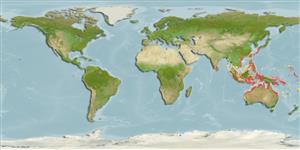Environment: milieu / climate zone / depth range / distribution range
Ecología
marino; salobre demersal; no migratorio; rango de profundidad 0 - 20 m (Ref. 86942). Tropical
Western Central Pacific: Philippines, Borneo, Singapore, Celebes, Papua New Guinea, New Georgia and Australia from the Northwest Shelf to Brisbane.
Tamaño / Peso / Age
Maturity: Lm ? range ? - ? cm
Max length : 58.0 cm TL macho / no sexado; (Ref. 9790); common length : 30.0 cm TL macho / no sexado; (Ref. 9790); peso máximo publicado: 655.00 g (Ref. 3132)
Espinas dorsales (total) : 9; Radios blandos dorsales (total) : 11; Espinas anales: 0; Radios blandos anales: 11. Prominent pit present behind upper eye. Preopercular spines short, upper two subequal. Infraorbital ridge usually smooth over eye. Suborbital ridge bearing 1 spine below rear of eye. Dorsal fin IX or I,VIII. Dermal papillae (usually 6-9 in adults) on upper surface of eye, longest branched and reaching well above supraorbital ridge. Short dark streaks usually crossing rays in dorsal and caudal fins.
Inhabits shallow rocky coastal areas frequently associated with seaweed beds and mangroves, most commonly at depths of less than 5 m (Ref. 9790). Also found on sand bottoms (Ref. 3132).
Life cycle and mating behavior
Madurez | Reproducción | Puesta | Huevos | Fecundidad | Larva
Allen, G.R. and R. Swainston, 1988. The marine fishes of north-western Australia: a field guide for anglers and divers. Western Australian Museum, Perth. 201 p. (Ref. 3132)
IUCN Red List Status (Ref. 130435: Version 2024-1)
Threat to humans
Harmless
Human uses
Pesquerías: pesquerías de subsistencia
Herramientas
Special reports
Download XML
Fuentes de Internet
Estimates based on models
Preferred temperature (Ref.
123201): 24.7 - 29.3, mean 28.6 °C (based on 2366 cells).
Phylogenetic diversity index (Ref.
82804): PD
50 = 0.5625 [Uniqueness, from 0.5 = low to 2.0 = high].
Bayesian length-weight: a=0.00708 (0.00421 - 0.01190), b=3.09 (2.94 - 3.24), in cm total length, based on LWR estimates for this species & (Sub)family-body (Ref.
93245).
Nivel trófico (Ref.
69278): 4.0 ±0.7 se; based on size and trophs of closest relatives
Resiliencia (Ref.
120179): Medio, población duplicada en un tiempo mínimo de 1.4-4.4 años (Preliminary K or Fecundity.).
Fishing Vulnerability (Ref.
59153): Moderate vulnerability (43 of 100).
